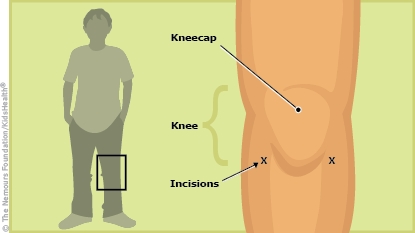After Meniscectomy: How to Care for Your Child
Your child needs to rest the knee so that it can heal from surgery. Kids need to wait at least 6–8 weeks before returning to all normal activities.


Meniscectomy is a type of surgery to treat a tear in the meniscus, a disk of cartilage that helps stabilize the knee and acts as a shock absorber between the thighbone (femur) and shinbone (tibia). The surgeon trims away the torn piece so that it doesn't interfere with the function of the knee.

-
Give your child any medications as prescribed by the health care provider.
-
Follow the health care provider's instructions regarding the removal of surgical dressings.
-
Your child should not take a bath, but can start showering on the third day after surgery. Wrap the knee in a plastic bag that is taped shut to keep the leg dry.
-
Apply a plastic bag of ice or a cold pack to the injured knee as often as the health care provider instructs. Keep the bandage or a cloth between the ice or cold pack and the skin to prevent frostbite.
-
If your child has swelling, numbness, coldness, or tingling in the foot, loosen the bandage around the knee and have your child raise the leg on a pillow to keep it above heart level.
-
Your child should do post-operative exercises as instructed by the health care provider.

-
Your child may stop using crutches as soon as it's comfortable to do so. This usually takes 3–5 days.
-
Teens who drive may do so once OK with the surgeon and no longer taking narcotic pain medication. Braces should be unlocked or removed before driving.

Your child:
-
Is unable to urinate (pee) the evening of the surgery.
-
Has swelling or numbness in the leg that is not relieved by loosening the bandage and raising the leg.
-
Has a lot of fluid or blood draining from the surgical site.
-
Has a temperature above 101°F on two readings 2–3 hours apart more than 48 hours after surgery.
-
Continues to have severe pain after 48 hours.

Your child: